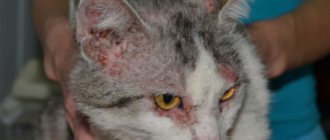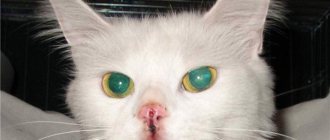Any disturbances in the functioning of the animal’s body immediately affect the general condition of the skin and coat. Often, with diseases of the digestive system or other organs, the skin begins to peel, dulls and hair falls out. Ear sores in cats can develop due to a lack of vitamins or minerals in the diet, as well as a decrease in the body's defenses.
In addition, the cause of the development of sores on the face and ears can be infectious or parasitic diseases. Only a qualified veterinarian has the right to determine the exact cause and prescribe appropriate assistance.
At home, trying to help a cat on your own is almost useless, as it may not give results. In addition, advanced infectious bacterial diseases cause serious complications.
Anatomy of the ears of cats and cats
The ear is the organ of hearing and balance.
It consists of outer, middle and inner. The outer ear includes the pinna (the visible part of cartilage covered by skin, fur, or hair) and the ear canal. The ear canals of cats and kittens are deeper and more conical than those of humans. This deeper canal is prone to the accumulation of dirt and wax, leading to inflammation and secondary infections.
Cats' hearing is many times more sensitive than humans'.
The middle consists of the eardrum and an air-filled chamber that contains 3 tiny bones, 2 muscles, the oval window and the eustachian tube.
The inner ear is a complex structure that includes the cochlea (the organ of hearing) and the vestibular system (the organ of balance).
Anatomy of a cat's ear
Inflammation of the middle and inner ear
SIMILAR ARTICLESMORE FROM THE AUTHOR
Blood in a cat's eye: causes and treatment methods
13 COMMENTS
I love pets, and especially cats. I was faced with the problem of an ear ulcer in my beloved cat, I had never encountered anything like this before, I found this site in time, made it according to your recommendations, my beloved cat felt better. thanks for the advice!
I once noticed that there was something wrong with the cat’s ear, that he was scratching it nervously and wouldn’t let me look there, I thought that he had an ulcer and after reading your article I realized that I was right! Thank you for such a clear description of diseases!
I'm afraid to treat cats or dogs myself.
Our cat was constantly scratching her ears at one time, scratching until they bled. They took me to the vet. It turned out that she had ear mites. They prescribed drops in the cat’s ears, and after a while everything went away.
my cat has a wound in his ear, or an ulcer, like a sore, I can’t even formulate. But he’s 15 years old and I can’t take him to the doctor, then we have a bad veterinarian, they’re only scamming money! Otibiovin helps for a short time. But tell me how to dry this The ulcer is deep, right behind the septum, in this hole where the drops usually fall.
Maybe brilliant green or panthenol? Please tell me, otherwise there is this brown discharge, blood, a terrible smell all over the apartment, the linen, and he himself is in great pain! I don’t know what to do. I tried both anandin and anadine+ - it didn’t help!
Two barn cats have chapped and reddened tips of their ears. I'm afraid to take it to the clinic; What if something is difficult to treat? After recently experiencing the death of a domestic cat as a result of arthrosis of the mandibular joint, the state is actually panicky. And I feel incredibly sorry for the courtyards...
Well, wait until they die, why did they take it? Flayer! >(
It’s a pity when pets also have diseases that humans are susceptible to. A person can at least talk about his feelings, but cats only need to be taken to a veterinarian.
My cats scratch their ears, but not often, especially in the morning. Comb out black crusts. We went to the vet. We took tests more than once. No toxoplasmosis was detected, no ticks either. Fungi of the genus Malassezia R b and mycoplasma were found in the eye wash. The ears were treated several times according to the following regimen: antibiotic, cycloferon, viferon, bifidumbacterin, ear drops, and we constantly clean the ears. Everything is useless, soon after treatment everything also accumulates and the cats scratch their ears again. Apparently the itching bothers me. Please advise what else can be done to help?
We recommend reading: Acetone Smell From the Mouth of Cats: Causes
I brought a cat from the street 2 months ago, discovered worms, bought the drug, they still haven’t disappeared, and today I noticed a smell and pus from 1 ear, washed it, the cat doesn’t scratch its ear, it’s not nervous…. What could it be, I would be glad for advice.
My cat's ear hurts and I can't touch it. Runs after me, meows, asks to be held, this has never happened before. The ear is not swollen, what should I do?
The cat has ear mites. They did a scraping. The inspector prescribed drops to the withers, the ears are still dirty, they completed the course and the ears are dirty. Otoferonol was dripped, the result was the same. They dropped stronghold and dropped otoferonol into the ears, after how many days can you start dripping otoferonol?
Treatment
First you need to carefully examine the animal's ears and try to understand what happened and what is bothering him. Making a correct diagnosis and identifying the cause of ear diseases in a cat is a sure way to a quick cure without unpleasant consequences. If it is a small wound, the owner can cope with the disease himself. But in more serious cases, only a doctor will help.
© shutterstock
Veterinary pharmacies have a number of drugs with different spectrums of action that help in the treatment of various ear diseases in cats. Remember an important point: cleaning your ears with cotton swabs is strictly prohibited . All discharge and dirt from the auricle are removed only with cotton pads.
Abscesses, hematomas, necrosis, tumors must be shown to a doctor who will decide on treatment of the disease and surgical intervention.
If any tiny thing or foreign body gets into the ear canal, it is also removed in the clinic. If left for a long time, it can cause an inflammatory process. Treating your cat's ears should not be delayed.
Inflammation of the middle and inner ear
Otitis of the middle or inner ear is a disease that can lead to irreversible consequences. Causes: ear mites, untreated otitis externa, tumors, head injuries, staphylococcal or streptococcal infection. Symptoms: copious purulent, bloody or serous discharge, squelching sound when pressed, unpleasant odor. The structure of the ear does not allow the source of inflammation to be seen with the naked eye, but from the behavior of the pet it is clear that she is seriously ill: the cat may press her ears, loses appetite, the temperature rises, and does not allow her to touch her ears. Treatment is prescribed by a veterinarian after examining scrapings and blood tests. As a rule, topical drugs are used in combination with antibiotics.
Otitis
Otitis is an inflammatory process that occurs in the inner, middle or outer ear of both humans and animals. In cats, it is often a complication of otodecosis. The most dangerous is damage to the inner ear. If left untreated and the disease progresses, the inflammatory process can affect internal tissues , and then lead to the animal becoming hard of hearing or losing hearing completely, as well as having problems with the vestibular system.
© shutterstock
Having discovered that discharge has appeared from the ear, you can definitely say that your pet has otitis media. This is the main symptom of ear disease. They may be clear or contain pus. It is especially dangerous when they acquire an unpleasant odor.
Most often, inflammation causes inflammation in a cat:
- uncomfortable state
- decreased activity
- loss of appetite.
Rarely does otitis media go away without visible discharge, but discharge from the ear is always present. As with the primary infection with ticks, you may notice that the cat seems to want to rid itself of the object that is bothering it, shaking its head and tilting its ear towards the diseased ear.
If the owner does not take action in time and does not begin treatment, the disease can go deeper and lead to the most difficult consequences.
Problems with coordination and an increase in body temperature are very alarming bells for the owner and a reason to immediately seek qualified medical help.
The cause of the disease can be not only infection with ticks, but also hypothermia. You can prevent it if you protect your cat from drafts in cool weather and dry it thoroughly after bathing.
There is no point in prescribing treatment for your pet on your own. Only a veterinarian can make an accurate diagnosis and select the correct drug treatment that will suit your cat individually.
Possible diseases
Common causes of red ears in cats:
- An allergic reaction may well cause your cat to become ill. Moreover, such an allergy occurs both to food, and to changes in the environment, to a medical drug. If the owner gave something unusual to his animal, then because of this the cat’s ears could turn red. Associated symptoms: difficulty breathing, discharge from the cat's nose (runny nose), the cat itches, peeling skin on the paws. Allergies in cats are treated with antihistamines prescribed by a veterinarian.
- Foreign object in the animal's ear. It happens that stones and grass could get into the ear canal, which irritate the ear from the inside. If a foreign body is visible from your cat's ear, you can try to remove it yourself.
- Injury. A cat's ears that are red on the outside may indicate mechanical damage. The cat could play or fight with other animals, tear its ear with its claws. Such a hematoma can also occur due to infection or insect bites. The best treatment is to apply a bandage to prevent the animal from aggravating the situation and causing further damage to itself.
- Scabies, which is caused by ear mites, also causes a foul odor from the ear and a brownish discharge.
- Otitis media is the most common reason why a cat has red ears. The disease affects not only the external auditory canal, but also the inner ear. The causes of the disease include ear mites, bacterial and fungal infections. The behavior of a cat with otitis media becomes restless: the cat rubs the sore ear and meows heavily in pain. To avoid otitis, the owner should monitor the hygiene of the pet’s ears: remove wax and wipe them. To treat this disease, a solution of boric alcohol and antibiotics are usually prescribed.
- Sunburns. In summer, a cat's ears are susceptible to sunburn and, as a result, dermatitis. At first, this disease is characterized by slight redness, and then the hair falls off the ear or bleeding begins. Solar dermatitis has a dangerous complication - squamous cell carcinoma, which occurs due to a cat's long exposure to direct sunlight.
- Lichen. At the initial stage of this disease, slight redness of the ear appears. Later the hair begins to fall out. It is better to treat this disease at the initial stage, before it begins to progress and the cat becomes completely bald. The microsporia test is carried out in a veterinary clinic.
A cat's red ears are not the only symptom of the disease. As a rule, the animal combs the diseased organ and rubs it, and does not allow the owner to even touch the ears. The cat is eating less than usual and is showing aggression. You can also notice something is wrong by the discharge, which emits an untidy odor from the ear canal. In some cases, the cat's temperature rises.
Diagnostic methods
Before starting treatment, it is important to make a diagnosis. This will help answer the question: why does the cat have a bald spot and a sore behind the ear? Diagnostics uses the following methods :
- external inspection of the damaged area;
- if baldness has begun around the ears, conduct a microbiological examination of the hair roots;
- general and special blood tests;
- scraping the epidermis;
- If tumors are noticed near the ears, an ultrasound or x-ray is performed.
The veterinarian should exercise extreme caution when carrying out all of these steps. If your cat's ears continue to hurt, it won't be easy to examine them given the animal's reaction. Particular care is needed in cases where there is a suspicion of the development of a disease dangerous to humans.
A cat has sores on its ears and head - possible causes of pathology
Any disturbances in the functioning of the animal’s body immediately affect the general condition of the skin and coat. Often, with diseases of the digestive system or other organs, the skin begins to peel, dulls and hair falls out. Ear sores in cats can develop due to a lack of vitamins or minerals in the diet, as well as a decrease in the body's defenses.
In addition, the cause of the development of sores on the face and ears can be infectious or parasitic diseases. Only a qualified veterinarian has the right to determine the exact cause and prescribe appropriate assistance.
At home, trying to help a cat on your own is almost useless, as it may not give results. In addition, advanced infectious bacterial diseases cause serious complications.
How treatment is chosen
If the cause of the disease is ear mites, the veterinarian will prescribe medications that are used to wipe the ears or drop them into the ears. These include Tsipam or Stronghold. A prerequisite for therapy in this case will be ear hygiene. Even after the disease has subsided, the owner needs to keep the area clean.
You need to act immediately if the cause of baldness is lichen. Here, the doctor may recommend treating the affected area of skin with sulfur ointment or Yam Bk. All these compounds effectively solve problems without posing a threat to the animal.
During treatment until the disease subsides, you should exercise extreme caution so as not to become infected yourself.
What treatment is prescribed?
When the diagnosis becomes known, a comprehensive treatment regimen is prescribed. For allergies and itching, the doctor will prescribe antihistamines and anti-inflammatory drugs, but in addition, it is important to identify the source of the pathological reaction and try to eliminate it. If inflammation and suppuration are noticeable on the sore, antibiotics are used. You can smear the affected areas with antibacterial ointments prescribed by your doctor, and if the disease is advanced, you will need an injection of the drug.
If skin parasites are found, you need to treat the cat's fur with special antiparasitic agents, and also carry out deworming at the same time. If a plaque formed on the head is a symptom of a fungal infection, the doctor will advise you to anoint the affected area with an antifungal agent. For acne, specialists at the Zoostatus clinic advise treating the affected areas with Miramistin or Chlorhexidine solutions. Antiparasitic injections will help get rid of ticks, as well as treating inflamed areas with special lotions and powders.
How to treat ear diseases in cats
Only a doctor can find out what ear problems a cat has.
Now we will dwell in more detail on the causes of the appearance of certain ear diseases, as well as on the issues of their treatment.
Gamatoma
Hematoma is the result of mechanical impact on the auricle. Mechanical damage includes blows, ear tugging, insect bites, and scratching.
Most often, a hematoma forms on the inner surface of the ear, somewhat less often on the outside. The ear increases in size, hangs down, there is limited, painful swelling that is hot to the touch. If left untreated for a long time, the pain only increases, and the hematoma can become infected with secondary microflora, leading to complications, for example, necrosis of the ear cartilage.
Externally, a hematoma manifests itself with the following symptoms:
- the cat constantly shakes its head from side to side;
- scratches the ear with its paws, damaging it even more with its claws;
- anxiety and nervousness may occur;
- When you try to pat the cat on the head, it shows aggression.
The treatment is not complicated. If no more than 48 hours have passed since the formation of the hematoma, then the ears are fixed with a bandage on the back of the head and cold is applied. After a day, heat and irritating ointments are used for further treatment.
If these manipulations do not lead to visible improvements, it is best to take the cat to a veterinarian who:
- will open the hematoma;
- remove blood clots;
- wash the resulting cavity with novocaine along with antibiotics;
- will give further recommendations on what the owner should do for a favorable outcome of the disease.
Lymphextravasate
Lymphatic extravasation occurs for the same reasons as a hematoma, and the symptoms are largely similar to it. The only difference is in the treatment. With this disease, the use of cold or heat is strictly contraindicated, and treatment should be carried out by a qualified specialist.
With lymphatic extravasation, the liquid must be aspirated, that is, pumped out using a syringe. A simple layman, without certain skills and dexterity for this procedure, will only harm the furry pet.
Sometimes aspiration of excess fluid does not lead to visible results, then a minor surgical intervention has to be performed in the form of a skin incision and more thorough removal of the contents of the cavity, followed by suturing.
Necrosis of the auricle
Necrosis of the auricle appears as a result of:
- prolonged compression of the auricle;
- during the transition of purulent processes from surrounding tissues;
- infection with pathogenic microflora of lymphatic extravasates, hematomas and abscesses.
During the development of a purulent process in the area of the auricle, in the absence of proper or timely treatment, foci of inflammation are opened with the formation of areas of skin necrosis (necrosis), which lead to the appearance of large ulcers. The ear cartilage begins to be visible through the damaged areas, its blood circulation is disrupted, it becomes black in color, and an unpleasant putrid odor appears. The cartilage tissue rots, and the ear becomes completely deformed.
Treatment of necrosis is only surgical - either complete amputation of the auricle or its necrotic part is performed. The main thing is that the process should not be started so that the inflammation does not spread to the inner and middle ear.
Foreign bodies in the external auditory canal
In a cat's ear you may find:
- ear wax plug;
- accidentally fallen sand;
- plant parts;
- insect larvae, lice and other items.
Sometimes the presence of a foreign body in a cat's ear canal does not cause any concern and may go unnoticed, but more often it irritates the ear, leading to inflammation.
For treatment, the foreign body must first be removed from the ear, after which the ear canal is washed with a solution of soda or hydrogen peroxide (3%), and a few drops of camphor oil are instilled to reduce the pain reaction.
Neoplasms
The most common neoplasms in the external auditory canal are papilloma, sarcoma, and fibroma, which grow over time, leading to deafness.
The main features are:
- anxiety;
- ear scratching;
- manege, uncoordinated movements;
- lowering the head towards the affected ear.
Treatment of tumors inside the ear is only surgical.
We recommend that you read more detailed articles about the signs and causes of inflammation of the outer, middle and inner ear (otitis), as well as an article about the treatment of otodectosis (ear scabies).
Video version of the article:
Author of the article: Marina Chuprinina, veterinarian, specialization parasitologist-bacteriologist, especially for Kota Obormot.
Solar dermatitis
The tips of an animal's ears can be damaged under the influence of ultraviolet and solar radiation, which is typical for light-colored animals.
Seizures in cats - main causes, symptoms, first aid, treatment and choice of drugs (110 photos)Polycystic kidney disease in cats - causes, diagnosis and symptoms of the disease. Treatment options and prevention of kidney disease (95 photos)
Tartar in cats - signs of the disease and methods of fully treating tartar (125 photos + video)
Timely treatment of cat ear disease caused by solar radiation will prevent the development of cancer; most often, removal of the tips of the ears is prescribed.
Why does my cat's ear run and smell bad?
Not all hearing diseases in animals are accompanied by the formation of lumps and swellings. If a cat’s ear is leaking and the discharge has an unpleasant odor, the owner has no less reason to worry. What common pathologies among domestic animals are accompanied by the described symptoms?
Otitis (ear inflammation) of various etiologies
Discharge accompanied by a foul odor is the first and most striking symptom of otitis media. This is the name for inflammation, which can spread to the outer, middle, and inner ear (and sometimes to all three structures at once). In its advanced form, the disease threatens the animal with hearing loss and dysfunction of the vestibular apparatus. Fortunately, otitis media is quite easy to detect due to its characteristic symptoms:
- A light or purulent fluid flows from the pet’s ear (less often from both). In the second case, the discharge has an unpleasant odor. The cat constantly shakes its head and tilts its sore ear down to help the fluid come out.
- The animal becomes passive. It sleeps a lot, trying to find a darker place to rest.
- In the later stages of the disease, the cat's body temperature may rise and coordination of movements may be impaired.
Otitis media can develop for various reasons. In cats, ear inflammation is most often caused by:
- hypothermia;
- tick infestation;
- fungal, bacterial or viral infection.
Foreign body in the ear canal
In some cases, ear inflammation can be caused by a foreign object entering the ear canal. What to do if one is discovered during the next examination of your pet?
You can remove a foreign body, wax plug or other “garbage” from a cat’s ear yourself, using small tweezers. The main thing is not to forget to disinfect the instrument. After the procedure, the auricle is wiped with hydrogen peroxide or soda solution. To relieve pain, you can drip a couple of drops of camphor oil into the ear canal.
Necrosis (death of tissue) of the ear
If your cat smells persistently of something putrid, and ulcers begin to appear on the inflamed ear, this indicates an advanced disease or improper treatment, as a result of which the animal has developed necrosis. This is the name given to the irreversible process of death of living tissues of the body. The spread of the disease can only be stopped by amputating the affected organ.
Otodectosis (ear scabies)
Unpleasantly smelling dark crusts inside the ear are a sign of an animal being infected with mites. Sometimes parasites can be seen with the naked eye. In other cases, the disease they cause—otodectosis—is recognized due to the unusual behavior of the infected animal. A cat suffering from ticks:
- shakes his head frequently;
- tries to scratch the inside of his ears with his paws;
- avoids touching.
Otodectosis is treated in two stages. First, the ears are treated with acaricidal preparations to destroy the mites. Then symptomatic remedies are prescribed to eliminate the consequences of infection.
Ear diseases and ear canal diseases
It is quite difficult to independently determine what disease cats have near the ear; even experienced cat owners cannot do it.
Scratching and injuries can occur for various reasons, but they are often associated with diseases of the ears, which come in several types and require mandatory treatment.
Overview of Possible Causes
It can take a very long time to independently look for the cause of the redness of a cat’s ears, and uncontrolled use of drugs can also harm the pet. This is especially true for adults, in whom, after the age of 10 years, the risk of tumors in the ear canal increases. There are many cases where a diagnosis made “by eye” resulted in long-term treatment for otitis media or ear mites, but in fact the reason lay in a formation that may be located deep inside the ear and cannot be seen without otoscopy. Based on this, we recommend that you familiarize yourself in advance with the possible causes of this symptom:
- If your cat's ears are red inside, then first of all it is necessary to exclude the possibility of an allergy. It can be triggered by poor diet, insect bites and contact with a potential allergen (less often). In terms of frequency of occurrence, food allergies, which are typical for decorative breeds, are in first place. Along with redness, discharge from the ears (in the form of brown or black mud), an unpleasant odor and severe itching often appear. In some cases, you can notice how the pet literally tears the ear area until it bleeds. Shaking the head more than once during the day can also be considered a characteristic sign. Flea dermatitis and ear mites, along with all the above symptoms, are also characterized by the appearance of flaking and black dandruff in the coat. The reaction can be triggered by just one flea. Getting her saliva on the skin is enough. Atopic dermatitis is considered an incurable but manageable disease. With a well-chosen treatment regimen, stable remission can be achieved. If an animal is allergic to flowering plants or fluff, seasonal exacerbations may occur. Treatment of all types of allergies begins with searching for and eliminating the potential allergen (treating for fleas and ticks, switching to hypoallergenic food, or removing plants from the house that may be poisonous to the pet). In difficult cases, a biochemical blood test may be necessary. You need to understand that most substances (dust, mold, hair from carpets, blankets or other animals) are almost impossible to eliminate from everyday life, so allergic cats will need lifelong maintenance therapy and antihistamines during periods of exacerbation.
- Otodectosis. A familiar problem to many cat owners who go outside for walks. The tick is transmitted through direct contact with an infected animal or through grooming items (collar, leash, clothing, comb, etc.). In the external environment, the parasite can survive up to 2 weeks. It always manifests itself acutely - red ears inside, brown discharge and peeling. At the same time, the pet regularly scratches the area of the temples and behind the ears, which is why large wounds can appear in these places. Because of this, otodectosis can be complicated by a bacterial infection. For diagnosis, you will need pieces of the epithelium of the ear canal and secretions, which are sent for microscopic examination. Under a microscope you can see the otodex mite, which is the cause of all the troubles. The universal preparations Stronghold (in the form of drops on the withers) and Frontline (instilled into the ear canal) are used as treatment. In most cases, two treatments 3 weeks apart are enough to get rid of the problem. Be sure to treat all animals that live with the infected cat, as even after complete recovery, a relapse is possible.
- Otitis. A common disease in cats of all breeds and all ages. In most cases it acts as a complication of the underlying pathology. The appearance of otitis media can be caused by an allergy, a formation in the ear canal, or a bacterial or fungal infection. Ear mites and fleas are the most common causes of otitis externa. This can cause red ears inside and foul-smelling discharge. To determine the cause of otitis, you will need discharge and deep pinches, which are sent for cytological and microscopic examination. In difficult cases, an otoscopy may be necessary to determine the likelihood of damage to the eardrum. To clean the ears, use special lotions (Otifri, Hartz), which are poured inside. Immediately after this, massage the area behind the ears and allow the animal to shake out the contents. When cleaning, it is not recommended to use sticks or other objects of a similar nature, which can create an ear plug.
Foreign bodies
Owners of animals who suffer from pain that appears as a reaction to foreign bodies located in the ear canal turn to specialists.
These can be specks of dust and specks, grass seeds or organic plant remains; experienced veterinarians know how to treat ear diseases in cats and carry out the necessary manipulations to alleviate the animal’s condition.
Signs of ear disease
The very first sign that something is wrong with your pet’s ears is the cat’s increased interest in the ears: she strokes them, scratches them, slightly covers them and tilts her head slightly towards the affected ear.
When examining the ears, the following is observed:
- redness and swelling of the outer surface of the ear canal;
- the presence of traces of inflammatory or parasitic discharge (dirty yellow, gray, black and with an unpleasant odor);
- the presence of visible damage to the auricle from constant scratching, as well as wounds and ulcers under the removed contents.
These signs indicate otitis externa, and this is a good reason to go to a veterinary hospital!
With otitis media and internal otitis observed:
- sore ears (sometimes prevents you from even touching);
- an increase not only in local temperature, but also in general;
- with a long purulent process, signs of general intoxication - general depression, lack of appetite, vomiting;
- the head is tilted towards the affected ear, slightly bent, the cat often shakes its head and meows at the same time;
- obvious purulent discharge from the ear (especially if the integrity of the eardrum is damaged), a squelching sound is possible when massaging;
- sagging of the eyelid and lip on the affected side if the inflammation affects the facial nerve;
- in particularly protracted cases - purulent dissolution of the ear cartilage and auditory ossicles;
- sudden jumps of the cat and fear due to unexpected painful shootings.
When the disease passes into the chronic stage, the clinical picture may not be so obvious:
- pet anxiety from periodic pain;
- thickening of the skin around the entrance to the hearing aid, as well as near the auditory membrane (visible only during instrumental examination with an otoscope).
Specific symptoms:
- allergic otitis is accompanied by hypersensitivity reactions in other parts of the body (urticaria, itching, swelling, etc.);
- with otitis caused by ear mites, dirty brown discharge is noted, after cleansing of which bleeding ulcers and wounds may remain. Usually both ears get sick at once;
- with otitis caused by the presence of excess moisture in the ear canal, the discharge will always have a liquid consistency, regardless of its characteristics (transparent or cloudy, serous or purulent);
- Fungal and bacterial otitis often has a dirty yellow discharge with a specific odor. Ears are hot. The diagnosis is made on the basis of laboratory cultures, when specific pathogens of the inflammatory process are isolated;
- with otitis media caused by excessive hair growth, hair is found deep in the ear canal. Before starting treatment, the hairs are removed;
- - in case of tumor inflammation or due to the ingress of foreign objects, the immediate causes are revealed during examination - in fact, neoplasms and foreign elements. Usually detected during examination using an otoscope.
Causes of the disease, and what signs indicate it is better to go to the veterinarian
Firstly, it is worth remembering that sores in the ear area are not always a sign of disease. The animal could have been injured during a fight or play. But if the wounds do not go away and their number increases, it’s time to sound the alarm. The reasons may be :
- ear mite;
- allergy;
- hormonal disbalance;
- manifestation of lichen
- neoplasms in the ear area.
Some of the reasons mentioned are diseases dangerous to humans. Such sores on a cat’s ears need to be treated. The owner should pay attention if the cat scratches its ears until it bleeds, sits or lies with its head tilted towards the sore ear, if along with sores bald patches appear, and attempts to examine and touch this place are met with active protest from your pet.
© shutterstock
Hematomas
Ear hematoma in dogs appears as a result of external contacts. This could be a fight with another dog, cuts from branches, bushes, plant thorns, or the result of hunting crows that can give back. Even if the pet emerged victorious from the fight, after such battles small seals may appear on the ears where blood accumulates. The bubble grows over time, and pieces of skin can die inside and pus can accumulate.
Symptoms of the disease begin literally two to three hours after the dog cuts its ears. When the owner begins to stretch this seal, the dog begins to whine in pain.
Ear hematoma in dogs
Under no circumstances should you burst or cut out the bubble yourself. If a hematoma is detected, you should contact your veterinarian.
Treatment depends on the nature of the problem:
- Most often, the pocket with blood and pus is sucked out with a syringe, the hair is pre-cut and the puncture site is treated with alcohol.
- If the first method is ineffective, all contents are promptly cleaned out.
- The wound is treated with an antiseptic, and the pet is given an antibiotic.
- Sometimes the cut bladder is drained.
- In all cases, the dog must wear a special collar.











